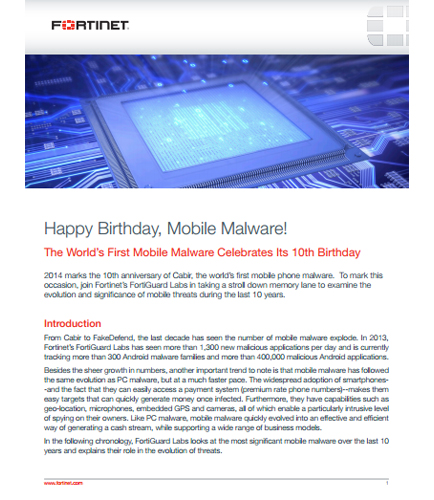
PROCESSING. PLEASE WAIT...

White Paper: Fortinet
From Cabir to FakeDefend, the last decade has seen the number of mobile malware explode. In 2013, Fortinet’s FortiGuard Labs has seen more than 1,300 new malicious applications per day and is currently tracking more than 300 Android malware families and more than 400,000 malicious Android applications.
Besides the sheer growth in numbers, another important trend to note is that mobile malware has followed the same evolution as PC malware, but at a much faster pace. The widespread adoption of smartphones--and the fact that they can easily access a payment system (premium rate phone numbers)--makes them easy targets that can quickly generate money once infected. Furthermore, they have capabilities such as geo-location, microphones, embedded GPS and cameras, all of which enable a particularly intrusive level
of spying on their owners. Like PC malware, mobile malware quickly evolved into an effective and efficient way of generating a cash stream, while supporting a wide range of business models.
In the following chronology, FortiGuard Labs looks at the most significant mobile malware over the last 10 years and explains their role in the evolution of threats.

By: Biometric Signature ID
Student Identification and verification is defined as the verification of identity is in person or remote (meaning from a computer or portable device) which is usually accomplished by the use of biometric credentials. This informative whitepaper brings you: What institutions need to know about the online student identification and verification Lack of compliance for student identification in present day environment New regulations on student identity verification Differences between academic integrity, student identity verification and financial aid fraud Meeting compliance using best practices for student identification and verification Download this whitepaper to learn more about the student identity and verification methods which reduces the risk by providing the industry’s most complete solution for student ID authentication.
By: PeerApp
Local content delivery is advancing to go beyond content caching to include other capabilities that optimizes network for quality and cost. Local content delivery offers an open CDN-like layer that sits within and augments next generation broadband networks, resolving the performance and scale bottlenecks seen in today’s global content delivery platform. Read this “The Evolution to Local Content Delivery” whitepaper that will give you everything you need to get started with the local content delivery solutions that offers an open platform augmenting broadband networks to accelerate Internet content delivery. What this whitepaper covers? Local Content Delivery: Benefits the Entire Value Chain Local Content Delivery: A Platform that Supports Market Evolution Local Content Delivery: Basis for monetization of OTT traffic


 2025 All Rights Reserved | by: www.ciowhitepapersreview.com
2025 All Rights Reserved | by: www.ciowhitepapersreview.com